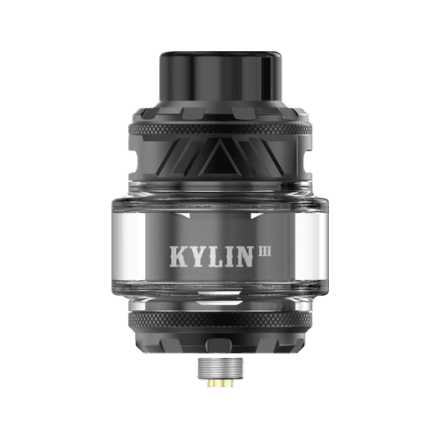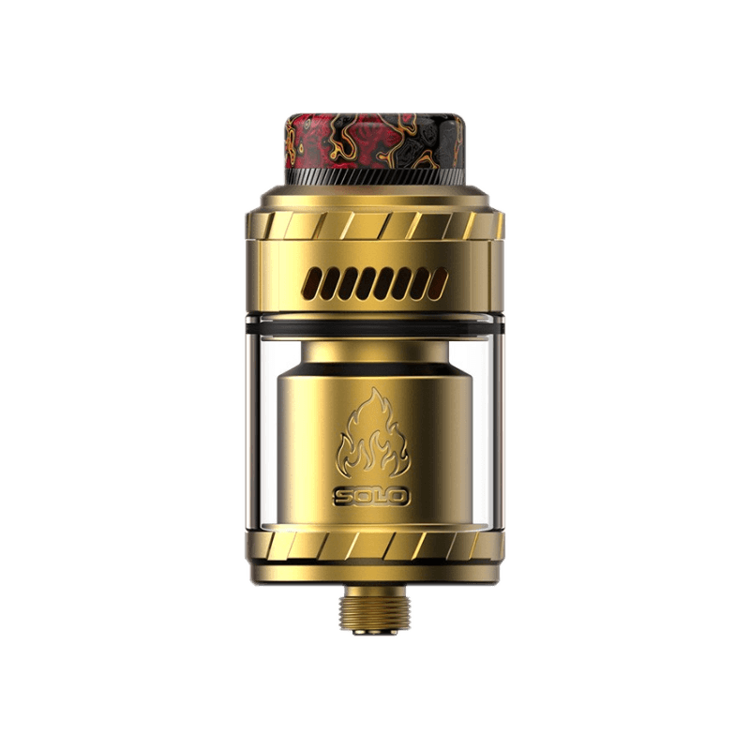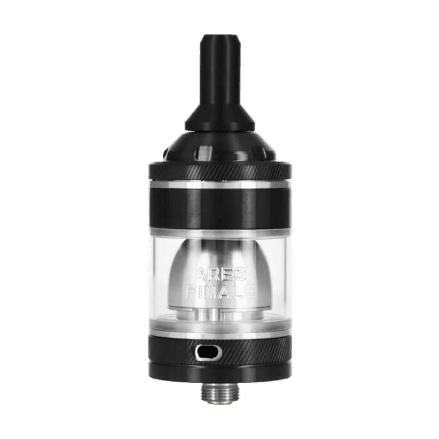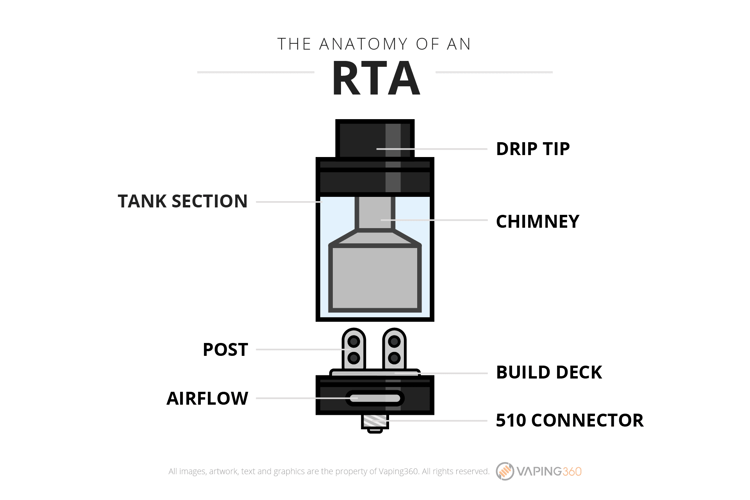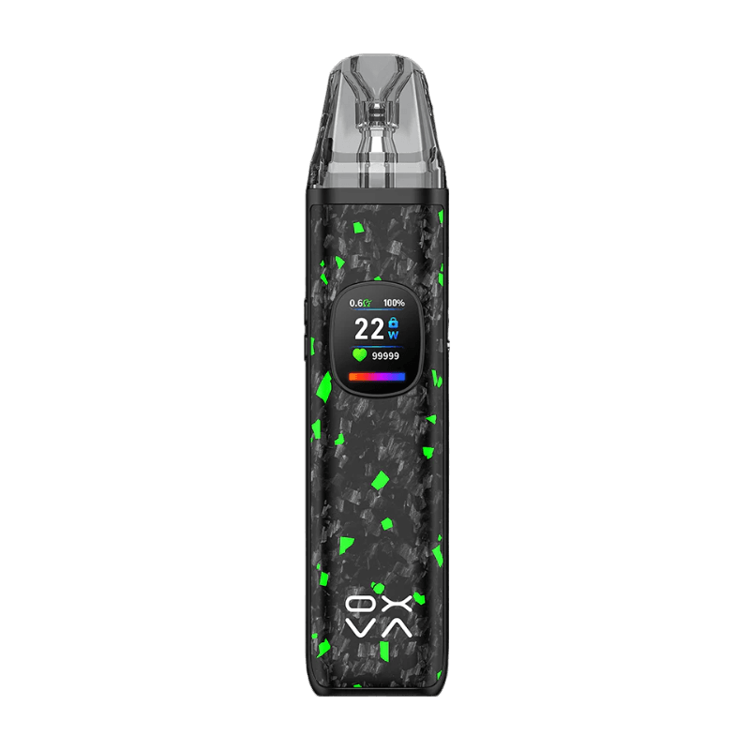
RTAs (rebuildable tank atomizers) combine the convenience of a tank with the versatility of a build deck. With countless options for coil configurations and tank capacities for your e-liquid, RTAs may just be the optimal vape tanks for convenience, performance, and for control of your vape!
Our list will be a guide for all those out there that either vape with clearomizers and want to start with RTAs, or even those that already use RTAs but want a bit of help deciding on their next one. Even RDA users can easily adapt with tanks now since many rebuildable tank atomizers are designed to provide a comparable experience.
What is an RTA?
An RTA is a rebuildable atomizer that utilizes a tank section. It consists of a build deck that also houses wicking channels, a chimney that connects the build deck to the top cap of the atomizer, a glass or plastic tank, and a drip tip.
Most RTAs will have some way of adjusting the airflow, usually in the form of a ring that is placed under or over the tank section. Many newer atomizers often implement additional airflow adjustment options that can modify the way air hits the coils inside the deck according to user preference.
How does an RTA work?
The way an RTA works is relatively simple. The user needs to build a coil (or more, depending on the design of the build deck) and install it on the build deck of the atomizer. After the coil is ready, it will have to be wicked, usually with cotton. The tails of the cotton are then placed in the wicking holes of the build deck.
Next step is filling the tank with e-liquid, and letting the wicks get saturated with the juice that enters the wicking channels. When inhaling, air enters the tank through the airflow holes and is channeled to the inside of the build deck. The air will hit the coils on its way towards the chimney, eventually reaching the drip tip.
What type of RTA is best for you?
Each type of RTA can provide a completely unique experience. Here are the main features to look at when choosing the perfect one for you.
Bottom airflow vs top airflow
Most RTAs will implement a bottom airflow system. Due to potential leaking, companies have also been designing top-airflow systems that channel the air to the side or bottom of the coils through different mechanisms. While these designs are more leak resistant, they sometimes end up sacrificing flavor, although newer top-airflow atomizers have been performing much better in the flavor department.
MTL vs DL
The draw of the atomizer is also an important categorization for RTAs. Atomizers that come with a small number of narrow airflow holes will produce a mouth-to-lung draw, while larger airflow slots or multiple holes will allow more vapor production and are geared towards direct-lung inhales.
Single coil vs dual coil
The vast majority of RTAs come with either single or dual-coil build decks. The number of coils is usually proportionate to the amount of vapor produced. Most single-coil RTAs range between an MTL to a restricted-DL draw, while dual-coils and above allow for much more airflow and vapor production.
RTA vs GTA-style
The build deck is placed on the base of the atomizer in standard RTAs, while Genesis (GTA) style atomizers come with raised decks that are positioned higher in the tank section. Deck placement will dictate the ways the RTA needs to be wicked, with GTA-style RTAs usually requiring longer wicks than standard RTAs.
Advantages of RTAs
RTAs have a number of advantages over other kinds of tanks and atomizers.
Compared to sub ohm and MTL tanks with replaceable coils, an RTA will generally perform on a higher level when built right. It will also provide a much more tailor-made experience, while saving money on coil purchases. Wrapping coils offers a huge savings over purchasing them. An entire roll of wire can make a large number of coils at approximately the same cost as one or two factory made coil heads; the user is less likely to run out of wire at an inopportune time since a roll of wire may last months or years. Similarly, a large package of organic cotton may last for more than a year. Moreover, the user of sub ohm tanks must rely on the manufacturer to continue providing coil heads for purchase, while the RTA user does not.
RTAs edge out RDAs in two departments. The first is e-liquid capacity. Users of RDAs must continually drip more juice into their atomizer while an RTA with large capacity may provide vaping enjoyment all day long before needing to be refilled. The second merit of RTAs over RDAs is that most do not leak if they are not kept upright. The way juice flow takes place on RTAs and the use of a chimney makes them less likely to leak if left at their side or even upside-down.
Compared to RDTAs, the main advantage of RTAs is size, closely followed by ease of wicking. Most RDTAs are much larger atomizers, while RTAs are generally more compact. Though RDTAs can be more challenging to wick properly, many of the newer products have been designed to alleviate most of these issues.
Tips and tricks for RTAs
Here are a few helpful tips to be aware of when using an RTA:
If you are unsure of your building skills and would like to see how you fare before you purchase a new atomizer, search for clearomizers that come with an RBA section. This way you will be able to use replaceable coils while practicing your building and wicking game. If you already own a tank that takes replaceable coils, check to see if there is an RBA deck available for it. In some cases, the RBA section is not included in the retail version, but can be purchased separately.
When building on an RTA (or an RBA) make sure the coils span across the air slots, especially on a bottom airflow atomizer. If the coil length is too short, it allows the wicks to drip e-liquid into the air holes, which can lead to gurgling and even flooding.
Another trick to prevent flooding is to be sure the wicks do not allow e-liquid to flow past them onto the deck. The wick tails must adequately block the juice feeding slots or holes. However, if the RTA begins to dry hit, then the user has too much wick blocking or hindering juice flow. Finding the perfect balance is key to achieving top performance.
Most modern RTAs allow the user to access the build deck at any time for re-wicking and are highly recommended for beginners and reluctant builders. Finally, be sure not to overfill the RTA. Leaving an air bubble allows juice to adequately flow to the wicks and exchange air for vaporized liquid.
The Freemax REXA PRO and REXA SMART are highly advanced pod vapes, offering seemingly endless features, beautiful touchscreens, and new DUOMAX pods.
The OXVA XLIM Pro 2 DNA is powered by a custom-made Evolv DNA chipset, offering a Replay function and dry hit protection. Read our review to find out more.
The SKE Bar is a 2 mL replaceable pod vape with a 500 mAh battery, a 1.2-ohm mesh coil, and 35 flavors to choose from in 2% nicotine.
Because of declining cigarette sales, state governments in the U.S. and countries around the world are looking to vapor products as a new source of tax revenue.
The legal age to buy e-cigarettes and other vaping products varies around the world. The United States recently changed the legal minimum sales age to 21.
A list of vaping product flavor bans and online sales bans in the United States, and sales and possession bans in other countries.
Find Your Perfect Product
Navigate our vape database precisely by customizing your filters. Find products tailored to your needs with options like price, category, and more.
Sort by:
Empowering Vapers Worldwide
As a recognized authority in the vaping world, Vaping360 draws over a million monthly visitors to read our in-depth reviews and guides, breaking news, and insights on the latest vaping products and events impacting the vaping world. Our mission is to achieve a healthier, smoke-free world.
